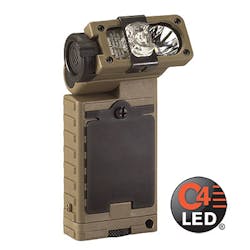Power and Concerns of Wearable Flashlights
Light is a powerful ally… and dangerous circumstance at the same time. With approximately 80% of law enforcement lethal force engagements occurring in conditions of low light, the lack of light is absolutely dangerous for all officers. Add to that the reality that 80% of the data we use to make decisions comes to us through our eyes. It’s obvious we need light to function and just as obvious that if we don’t manage the light we control properly, it can become detrimental for us. After all, bad guys can only attack what they can see as well, and if all they see is the light we’re holding, then they’ll attack that light. Therefore, it behooves us to use our flashlights in a strategic and safe fashion. This is a very important consideration when selecting between a handheld or wearable flashlight.
The wearable flashlight has great strengths in convenience, and technology has evolved to the point that very light yet very powerful lights can be easily clipped on to part of our apparel OR simply strapped onto our bodies. Wearable flashlights now include lights that can be clipped onto ball caps, attached to helmets (of various sorts), strapped to your head, arm, wrist or even the back of your hand. Wearable lights offer the strength of convenience because you don’t have to hold them, freeing your hands to do other things. Additionally, if worn properly, they are always pointed where you are looking, providing the light you need to function. That is, after all, their purpose.
GT Distributors has a wide variety of wearable lights available as well as some accessories that can convert your handheld “tactical” light into a wearable light. Where wearable lights really show their strength in the public safety community is in search and rescue work. Without a perceived threat to be wary of, law enforcement and rescue workers can wear one or more lights as they search a given area. That light is of vital importance to avoid hazards and uneven terrain that can cause injury to those searching.
Available in rechargeable variations as well, wearable lights can increase efficiency in search and rescue efforts while not increasing the count of tools that have to be carried. If there’s not a wearable light in your response kit you should see what’s available and upgrade your capabilities by adding one… or more.
Editor's Note: This article is a paid for and sponsored piece of content purchased by GT Distributors.



